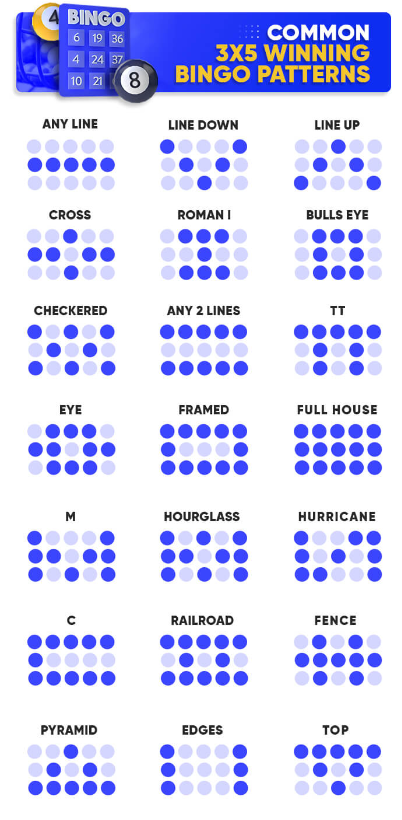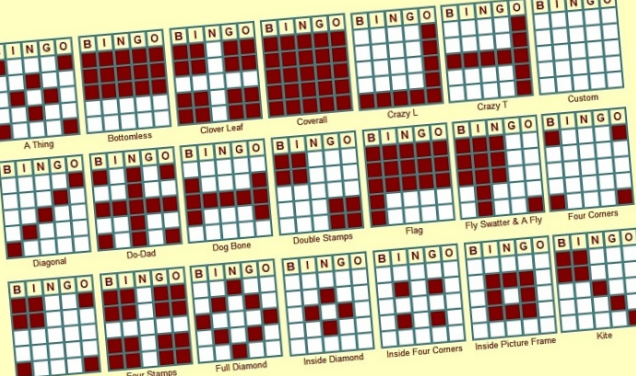The most common winning line in bingo is the horizontal line across the center.
nderstanding Bingo Lines
Bingo, a game cherished by many, isn’t merely a game of luck; it’s also about understanding patterns. The bingo board holds a series of lines and patterns, each with its significance and odds. Here’s a detailed breakdown of these lines:
Horizontal Lines
In traditional Bingo games, especially the 5×5 grid, there are five possible horizontal lines to win. This pertains to completing a line of numbers horizontally across one row of your bingo card. Many players consider this the simplest form to recognize because of its straightforward trajectory from left to right. More about horizontal lines can be found on Wikipedia.

Vertical Lines
Vertical lines refer to completing a line of numbers vertically down one column of your bingo card. In a 5×5 card, there are again five potential vertical lines. This pattern is commonly overlooked, especially by newer players, as our eyes tend to scan things horizontally. However, keen players often capitalize on this pattern for quicker wins. Dive deeper into bingo strategies on Wikipedia.
Diagonal Lines
Arguably the trickiest of the basic patterns, diagonal lines require players to complete a line from one corner of the bingo card to the opposite corner. There are two potential diagonal lines in a classic bingo game: from the top-left to bottom-right and vice versa. Although it might seem challenging, many find this pattern rewarding and exhilarating. Learn more about the history of bingo and its patterns on Wikipedia.
Four Corners
As the name suggests, this pattern requires players to mark off the four corner numbers on their bingo card. Although it only requires four numbers to win, the random nature of number calling can make this pattern just as challenging as any other. This pattern is particularly popular in certain variations of bingo games. Explore the different versions of bingo on Wikipedia.

The “X” Pattern
This intriguing pattern is a combination of the two diagonal lines, forming an ‘X’ on the bingo card. It’s considered a more advanced pattern due to its need for players to focus on two diagonals simultaneously. Although not as common in regular bingo games, it offers a unique challenge and a change of pace from the traditional lines. Get more insights on advanced bingo strategies on Wikipedia.
Factors Influencing Line Wins
When diving into the fascinating world of bingo, it’s essential to consider the myriad factors that influence line wins. While luck plays a significant role, understanding these elements can elevate your gameplay and strategies. Here’s a comprehensive look at these factors:
Number of Players
The number of players in a bingo game directly impacts your chances of winning. With more players, the odds of someone else marking off a specific line or pattern before you increase. Conversely, fewer players might seem like an advantage, but it can also mean reduced prize money. Balancing the thrill of competition with the potential rewards is crucial. Discover the dynamics of player influence in games on Wikipedia.
Card Variations
Every bingo card is unique. The numbers and their arrangement can influence the probability of securing a win with a particular line or pattern. Some cards might seem ‘luckier’ based on past wins, but it’s crucial to remember that each game is a fresh start. Moreover, in some bingo versions, players can select their cards, so understanding the layout can offer a slight edge. Dive into the nuances of card variations on Wikipedia.

Game Variations
Bingo isn’t a one-size-fits-all game. Different regions and communities have introduced their tweaks and variations. For instance, the UK version of bingo differs significantly from the US one, affecting line win strategies. Additionally, some game variations introduce special patterns or rules, which can influence line wins. Staying updated with these variations can provide a distinct advantage, and being adaptable is key. Learn more about the different bingo game types on Wikipedia.
Statistical Analysis
Statistical analysis provides a more in-depth and structured approach to understanding bingo. Through this method, we can make more informed predictions about the game, separate myths from facts, and enhance our strategies. Here’s an exploration of the quantitative side of bingo:
Data Collection Methodology
Collecting data is the first step in any statistical analysis. For bingo, this means recording outcomes of several games, noting the winning lines, patterns, and the time taken to achieve them. Tools like tracking sheets or software can aid in this process. Over time, this data compilation can reveal fascinating insights about the game’s nature. Dive deeper into data collection processes and their importance on Wikipedia.
Popular Line Wins: Trends & Patterns
Once data is amassed, patterns may start to emerge. For instance, one might notice that horizontal lines tend to win more frequently during specific times or in certain game variations. Recognizing such trends can guide players in choosing their strategies, like which lines to focus on during a game. While no pattern guarantees a win, being aware of them can improve one’s chances. Explore the significance of trends in games on Wikipedia.

Probability and Odds of Winning
Understanding the probability and odds is crucial for any game enthusiast. In bingo, this translates to knowing the likelihood of a particular line or pattern winning based on historical data. For instance, if diagonal lines have won 30% of the time in past games, one can infer its probability in future games. However, it’s essential to remember that each game is independent, and past results don’t guarantee future outcomes. Still, having this knowledge can inform gameplay strategies. Delve into the intricate world of probability and odds on Wikipedia.
Strategy and Tips
While bingo is undeniably a game of chance, seasoned players often employ various strategies and tips to optimize their playing experience and potentially boost their odds. These tactics, shaped by observation and experience, can make the game more engaging and competitive. Here’s a dive into some of the most prevalent strategies:
Selecting Cards
One of the first decisions a player faces is selecting their bingo cards. While all cards have an equal chance of winning theoretically, many believe that cards with a diverse spread of numbers or those that avoid common number groupings can increase winning chances. Additionally, some players have personal preferences or “lucky numbers” they tend to stick with. For a comprehensive understanding of number theory and its potential application in games, you can visit Wikipedia.
Monitoring Multiple Cards
Playing with multiple cards simultaneously can increase your chances of winning. However, it also requires greater attention and quick reflexes. The key is to find a balance – too many cards can become overwhelming and counterproductive, while too few might reduce winning odds. Tools like bingo daubers and electronic tracking systems can assist in managing multiple cards. Learn more about multi-tasking and its effectiveness on Wikipedia.
Timing and Game Selection
The timing of when you play bingo and which games you choose can influence your experience. Some believe playing during off-peak hours, when fewer players are participating, can increase winning chances. Additionally, selecting games with special rules or bonuses can provide additional avenues for victory. Understanding the rhythm and patterns of game schedules and offerings can be beneficial. For a deeper dive into optimal game selection strategies, check out game theory on Wikipedia.
Real-world Testimonials
Real-world testimonials offer a window into the genuine experiences and insights of those deeply entrenched in the world of bingo. By hearing from both regular players and those managing the game halls, we can gain a more rounded perspective on the game’s intricacies and allure. Here’s a snapshot of their insights:
Experiences of Regular Players
Regular players often have a wealth of stories and experiences to share. From their first win to their biggest loss, from friendships formed over shared cards to the thrill of shouting “Bingo!” in a crowded hall, their narratives are rich and varied. Some players might speak about their favorite strategies, while others may discuss the sheer joy and community feel of the game. They might even talk about their special rituals or lucky charms they bring to each game. The emotions, strategies, and social connections formed in the bingo community can be further understood through social psychology on Wikipedia.
Insights from Bingo Hall Managers
Bingo hall managers provide a unique perspective, having seen countless games and interacted with a multitude of players. They often share behind-the-scenes tales, from managing the logistics of large jackpots to handling disputes and ensuring fair play. Managers might discuss the evolution of the game, technological integrations, and the future of bingo halls in an increasingly digital world. Their insights not only shine a light on the operational aspects of bingo but also on the game’s cultural and communal significance. Dive into the business and management side of such establishments on Wikipedia.